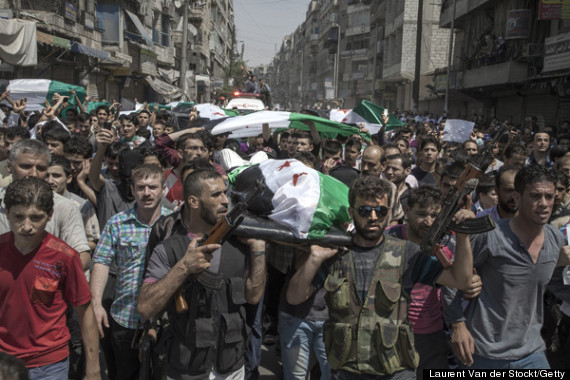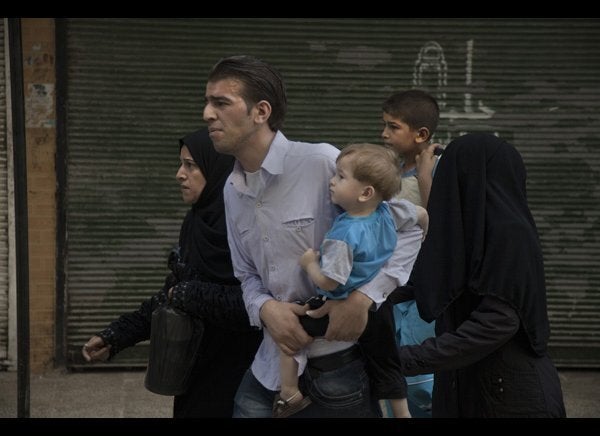Photojournalist Laurent Van der Stockt has pulled back the curtains on the bloody sectarian conflict in Syria in a series of images taken during a recent trip to Aleppo. Over the past few weeks, the war-battered city has been the site of intense shelling, air attacks, and clashes between Bashar Assad's troops and rebel forces.
In a departure from the stunning photographs that poured out of Libya during the country's revolution in 2011, Syria's uprising has been documented largely by grainy mobile uploads and shaky footage posted online by activists. Bashar Assad's government bars most foreign journalists from entering the country, yet each day citizen journalists in Syria post media purporting to show grave atrocities carried out by the regime against its people.
By contrast, high-resolution photos from Syria's official news agency, SANA, clearly show damage from bombings the regime claims were carried out by "terrorists" (a blanket term the state applies to members of the opposition). The back-and-forth propaganda war between rebels and government forces has left international news agencies with few independently verifiable reports, though rights groups have condemned abuses by both sides.
Photojournalist Laurent Van der Stockt visited Aleppo at the end of July and early August to photograph Syria's biggest city. In the Q&A below, HuffPost World goes behind the scenes with Van der Stockt to discuss some of the photos published in our weekly iPad magazine, Huffington.
Van der Stockt, who by his own account has covered almost every major conflict in the past 20 years, calls the violence in Syria the "worst and widest" by a government against its people that he has witnessed. Activists estimate more than 20,000 people have been killed since the uprising began in March 2011.
Read the full Q&A below and see more photographs by Laurent Van der Stockt in Huffington.
When and where were these photos taken and how did you get there? The pictures taken outside of Aleppo were taken between July 12 and July 21, 2012, and the pictures taken in Aleppo were taken between July 22 and August 8, 2012.
Did you have any trouble with the government prohibiting you from entering the country? I entered illegally in Syria. I had to hide inside private homes as to not be seen by pro-government Syrians and had to protect my hosts from retaliation. When the Northern region was completely taken over by the FSA [Free Syrian Army], I no longer had to hide. As a foreign photographer it is almost impossible to work safely in government-controlled areas.
Describe the violence. Is the fighting widespread or did you have to scope out flashpoints to take photographs? There are many types of violence in Syria. One type of violence that is widespread and effective against the revolution is the extreme, barbaric, and varied retaliations on an individual, his relatives, or his friends who are in any way involved with or interested in any anti-government idea or action. They also bomb civilian areas with planes, helicopters, tanks and artillery. It is important to note that some pilots continue to obey but will target safe empty spots to avoid casualties. In the North region, the violent clashes are now concentrated in Aleppo in the frontlines in Salaheddine and also in FSA and government districts against snipers and the so called "shabiha." [Editor's note: Shabiha are pro-government militiamen.] What are residents doing day-to-day when there is a break in fighting? In the countryside farmers and their employees continue to work. When shellings and bombings increase, they first move children and women to another village or sometimes even outside the country. At night civilians sometimes go out into the fields so they are not sleeping in their village which is being targeted and will come back at sunrise.
In Aleppo, a lot of residents stayed home the first few days of the FSA attacks but then went out more and more in the streets the following days. Shops and markets reopen quickly after attacks and civilians understand that even if the town is bombed or shelled they have to take the risk of a normal life without fearing the government and shabiha repression. One of your photos appears to show a family fleeing. Do you know where they were headed and from where they were leaving? Both families and individuals are moving temporarily or permanently -- to a different area, to the other sides of the city or country, to a relative's house, or to Turkey. Moving depends on a lot: when they flee, government retaliation, fear, shelling, lack of supplies, their social level, and how much access they have to transportation and money.
One of your photos features a pile of trash. Have government services stopped?
One of the first government retaliations in Aleppo, even before the arrival of the FSA fighters, was to not provide any services to populated districts where people were trying to peacefully demonstrate.
How does this compare to other conflicts you've covered?
This is the worst and widest range of violence of a government against its own population that I have ever seen, and I have covered almost every conflict for more than 20 years.
What do you think the media could do better in covering the conflict in Syria?
Doing their job. The access to the North area is not a difficult problem anymore. The FSA, a mixture of residents and deserters of the Syrian Army, welcome the media and help as much as they can. In the northern area and in Aleppo these last two weeks, the important news agencies were reporting wrong information -- sometimes that included Syrian government propaganda and no one was checking it. A huge amount of the media around the world believed this information and passed it along without checking it either. For instance, August 9th newspapers and websites all around the world announced the withdrawal of FSA forces from Aleppo, when in reality, not one group left the city. In such a well reported and psychological conflict –- the people are fighting for their freedom first did it without violence -- are not receiving any help from other countries. They have been greatly affected. The sentiment of injustice and abandonment is growing and will have a real impact on the consideration of Western countries in the minds of the people of the future Syria.
Our 2024 Coverage Needs You
It's Another Trump-Biden Showdown — And We Need Your Help
The Future Of Democracy Is At Stake
Our 2024 Coverage Needs You
Your Loyalty Means The World To Us
As Americans head to the polls in 2024, the very future of our country is at stake. At HuffPost, we believe that a free press is critical to creating well-informed voters. That's why our journalism is free for everyone, even though other newsrooms retreat behind expensive paywalls.
Our journalists will continue to cover the twists and turns during this historic presidential election. With your help, we'll bring you hard-hitting investigations, well-researched analysis and timely takes you can't find elsewhere. Reporting in this current political climate is a responsibility we do not take lightly, and we thank you for your support.
Contribute as little as $2 to keep our news free for all.
Can't afford to donate? Support HuffPost by creating a free account and log in while you read.
The 2024 election is heating up, and women's rights, health care, voting rights, and the very future of democracy are all at stake. Donald Trump will face Joe Biden in the most consequential vote of our time. And HuffPost will be there, covering every twist and turn. America's future hangs in the balance. Would you consider contributing to support our journalism and keep it free for all during this critical season?
HuffPost believes news should be accessible to everyone, regardless of their ability to pay for it. We rely on readers like you to help fund our work. Any contribution you can make — even as little as $2 — goes directly toward supporting the impactful journalism that we will continue to produce this year. Thank you for being part of our story.
Can't afford to donate? Support HuffPost by creating a free account and log in while you read.
It's official: Donald Trump will face Joe Biden this fall in the presidential election. As we face the most consequential presidential election of our time, HuffPost is committed to bringing you up-to-date, accurate news about the 2024 race. While other outlets have retreated behind paywalls, you can trust our news will stay free.
But we can't do it without your help. Reader funding is one of the key ways we support our newsroom. Would you consider making a donation to help fund our news during this critical time? Your contributions are vital to supporting a free press.
Contribute as little as $2 to keep our journalism free and accessible to all.
Can't afford to donate? Support HuffPost by creating a free account and log in while you read.
As Americans head to the polls in 2024, the very future of our country is at stake. At HuffPost, we believe that a free press is critical to creating well-informed voters. That's why our journalism is free for everyone, even though other newsrooms retreat behind expensive paywalls.
Our journalists will continue to cover the twists and turns during this historic presidential election. With your help, we'll bring you hard-hitting investigations, well-researched analysis and timely takes you can't find elsewhere. Reporting in this current political climate is a responsibility we do not take lightly, and we thank you for your support.
Contribute as little as $2 to keep our news free for all.
Can't afford to donate? Support HuffPost by creating a free account and log in while you read.
Dear HuffPost Reader
Thank you for your past contribution to HuffPost. We are sincerely grateful for readers like you who help us ensure that we can keep our journalism free for everyone.
The stakes are high this year, and our 2024 coverage could use continued support. Would you consider becoming a regular HuffPost contributor?
Dear HuffPost Reader
Thank you for your past contribution to HuffPost. We are sincerely grateful for readers like you who help us ensure that we can keep our journalism free for everyone.
The stakes are high this year, and our 2024 coverage could use continued support. If circumstances have changed since you last contributed, we hope you'll consider contributing to HuffPost once more.
Already contributed? Log in to hide these messages.




